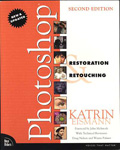 |
PHOTOSHOP. Restoration and Retouching by Katrin Eismann Book review by Mariana Gruener Published by New Riders |
On the introduction of this book we read:
“Our photographs contain our memories and our legacy, they connect us to our family and friends. Even if they are cracked, yellowed or damaged, we don’t throw them away. No matter how tattered or faded a photograph is, it still helps us remember and learn about the past”.
The latest edition of Photoshop by Katrin Eismann helps everyone -from retouching personal photographs to professional portraits- to get started in Photoshop 7.
The structure of the book is based on the order of steps Katrin recommends for working on the images. First, there are your Photoshop basics, then file organization and finally the use of tools. She suggests to do color correction prior to eliminating impurities and damages of the image. She shows several creative ways for retouching portraits and the techniques used by the pros in advertising. Katrin illustrates the reader how to solve a problem in several manners sharing tips from her expert friends.
One of the features of this edition is the possibility to download the images used in the book for practice from www.digitalretouch.org
Other good pieces of advice from Katrin include learning the shortcuts on the keyboard, thus keeping away from the arm strenuous mouse and avoiding filters and utilities that do not have specific values for risk of over altering the image. She stresses the importance of working with layers, of grouping them and assigning them names and keeping the original image unaltered. This enables you to do corrections step by step avoiding waste of time and effort. She also suggests to step back and taking a good look before using the most obvious tool. Seeing how the image is constructed will take you to the more efficient ways of dealing with a problem.
Kim stresses that there are no recipes, it is important to be creative and have good knowledge of the tools to use them in different kinds of images. Even though the book focuses on portrait restoration and retouching and the many ways to increase quality, its techniques and tips are useful for other kinds of photography.
One of the great things about this book it that the multiple techniques and ways shown in it keep you from giving up on significant photographs that are practically on the verge of disappearance.
The book focuses on making the subject look good. Chapter 9 deals with techniques to make people look slimmer or teeth whiter, improving the tones of skin color and deleting unwanted individuals. It is quite a fun chapter however, as Katrin herself points out, these recommendations are based on certain aesthetic standards that emphasize a prevailing beauty ideal that is not the only one that exists or should exist.
Chapter 10 will come in very handy for those dwelling in advertising and fashion photography. These kind of images demands a subtler retouching that is vital for advertisements, such as flashlights reflecting on the eye, trimming down the inexistent potbelly of a model, or making her look tanned. The book has a light mood, cracking a few jokes while explaining the different techniques. The book is didactic and has plenty of examples, but in my opinion practicing with the same set photographs to try to get the same results of the book limits the understanding of the tool’s capabilities, to solve a different problem would force to improve the learning of the technique.
There is a number of books on Photoshop on the shelves, the programs evolves every year, on the one hand getting user-friendlier but on the other more complex. When selecting a book one must take into account that Photoshop is a very extensive program that can be used for very different purposes, from the slight improvement of a good photograph and the restoration of a very damaged one to the creation of imaginary worlds or people. There are no limits to what you can do with Photoshop if you have an idea; it is a question of deciding what you want to know. If you want to go for portraits, Katrin Eismann’s book is a good choice.
Mariana Gruener
Send your comments on this review to: mgruener@yahoo.com
|
 Katrin
Eismann
Katrin
Eismann